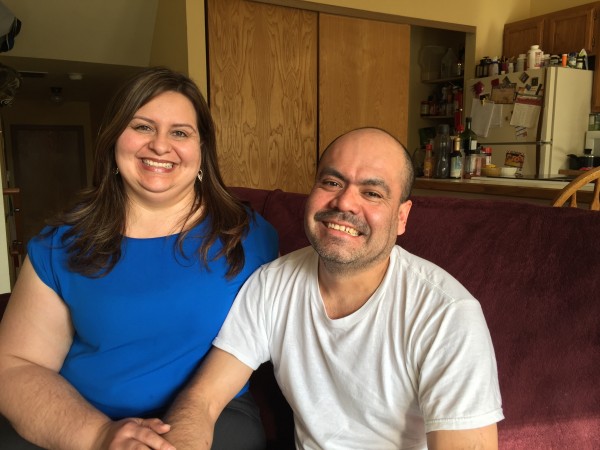
Stereotypes about Mexican immigrants in the United States abound, but everyone has a unique situation. This is the tale of one couple with two very different stories.
Dayra and Mario Valades sit on the couch of their pleasantly cluttered apartment. Plants for their garden and piles of mail fill the table. It’s one of the rare times they’re both home together in the early evening. Mario is a bit of a workaholic.
“When I don’t work – it’s hard for me to go to sleep. I get sick if I don’t work for three or four days,” he says.
“That’s true,” Dayra chimes in. “If he don’t work, he gets sick.”
He says he’s always been this way. He started working full-time when he was 17 and crossed the border from Mexico to California, nearly 30 years ago. He talks about the trip like it was a casual two-hour walk, even though he came into the United States without legal documents.
“Yeah, it was scary. But I didn’t care,” he laughs. “They told us if you get caught, they’re not going to hurt you. They’ll just send you back. And I thought, ‘OK.’”
Mario’s tone is light, but he didn’t really have a choice. Like many others, he needed to support his family and there wasn’t work near his home.
“My dad passed away… and my sisters were young. I felt like I had to take over.”
He arrived in California then soon moved to Washington to pick fruit and hops. After a few years, he knew there wasn’t a future in it. “I (have) seen people who were working there (for) 30 years, and we got paid by the hour and they were still working the same like 30 years ago.”
So Mario bought himself an English course with audiocassettes and books. He’d return from the fields after a long day and study in the late afternoon. After a few months, he joined Job Corps in Oregon. There, he took proper English classes and learned a trade – building maintenance and floor installation. On the advice of a friend, he moved to Alaska in the early 1990s because the pay was better. Soon after he met his first wife, had a son, and decided to apply for his green card. He says back then, it was easy.
“I didn’t have any problem with the law or anything. I didn’t have any tickets or anything,” he says. Immigration officials “didn’t ask me for anything. They just called me to immigration, took a picture of my fingerprints, and make sure it was me, and yeah.” Done. Easy. He stayed in Alaska and started his own business.
By the time Dayra arrived nearly 15 years later, things had changed a bit. She first came to Alaska as a tourist, then as a researcher. That’s how she met Mario – she interviewed him for her master’s thesis on Mexican immigration to Alaska.
“Yeah, we started hanging out and we kind of fell in love,” Mario recalls, looking at his wife and giggling. “I told her not to leave. I wanted her to stay here.”
“But I left!” she exclaims.
Dayra wanted to return to Mexico to finish her master’s degree and deciding to come back to Alaska to stay was hard. She had friends and family in Mexico and she didn’t need to move north to support anyone financially. According to the Pew Research Center, by 2008, more Mexicans were leaving the U.S. to return home than were arriving to find work.
“And then I came here I went from being a really busy person to not working or going to school or other things. So I was at home most of the time. And he was working. Well, he works a lot. And that was hard.”
Eventually, Dayra started to meet people and learned about job searching in Alaska. She found a position, but she says she doesn’t really put her master’s degree to its full use. When the couple decided to get married in 2008, the process for Dayra to get a green card seemed much harder than what Mario went through a decade earlier.
“They were pretty confusing, the forms were. Well, they were to me.”
A person helped them fill out the forms and a month later, they were called into the immigration offices for an interview. Mario had gotten his citizenship shortly after they started dating. Dayra says officials seemed suspicious of her motive.
“They asked me in that tone like, ‘So, then, he was really attractive to you?’” she says with disgust. “No. He was before.” They were dating before she knew he had even applied.
“They just wanted to see if we really were gonna get married and were gonna stay together,” Mario interjects. “Because like I said before, a lot of people do it just to get their citizenship.”
It may be a common assumption that people just get married to stay in the US, but U.S. Citizenship and Immigration Services doesn’t actually track marriage fraud. Most petitions for permanent residency for spouses are approved. Within about a year, Dayra received her green card, which they both say is a relief, in part because they feel like attitudes towards immigration have changed. Authorities are more likely to check their documents.
“Now they check for everything,” Mario says. “Even if you want to buy property or something they check it out.”
But they both also say that they don’t experience any discrimination in Anchorage. They’ve built their lives here and plan to stay.
